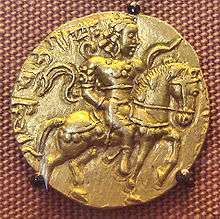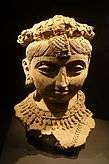Gupta (king)
| Gupta | |
|---|---|
| Maharaja | |
| Founder of Gupta dynasty | |
| Reign | c. late 3rd century |
| Successor | Ghatotkacha |
| Issue | Ghatotkacha |
| Dynasty | Gupta |
| Gupta Empire 320 CE–550 CE | ||||||||||||||||||||||||||||||||||||
|---|---|---|---|---|---|---|---|---|---|---|---|---|---|---|---|---|---|---|---|---|---|---|---|---|---|---|---|---|---|---|---|---|---|---|---|---|
|
||||||||||||||||||||||||||||||||||||
Gupta (fl. late 3rd century CE) was the founder of the Gupta dynasty of northern India. He is identified with king Che-li-ki-to (believed to be the Chinese transcription of "Shri-Gupta"), who, according to the 7th century Chinese Buddhist monk Yijing, built a temple near Mi-li-kia-si-kia-po-no (Mṛgaśikhāvana) for Chinese pilgrims.
Name
Gupta is not attested by his own inscriptions or coins, although some seals and coins have been wrongly attributed to him.[1] The earliest description of him occurs in great-grandson Samudragupta's Allahabad Pillar inscription, and is repeated verbatim in several later records of the dynasty.[2]
The Allahabad Pillar inscription names Samudragupta's ancestors as Shri Gupta, Shri Ghatotkacha, and Shri Chandragupta.[2] Some earlier scholars believed that the name of the dynasty's founder was "Shri-gupta" (IAST: Śrigupta), as Gupta doesn't appear to be a given name. However, it is now generally agreed that Shri is a honorific title and not an integral part of the king's name; "Gupta" was the actual name of the king. The Vishnu sahasranama mentions Gupta among the 1008 names of Vishnu, which suggests that it can be used as a given name.[3] The name derives from the word gup ("to protect").[4]
Date
Gupta most probably ruled in the second half of the 3rd century, although his reign cannot be dated with certainty based on existing evidence. Various estimates of his reign include:[5][1]
- R. K. Mukherjee: 240–280 CE
- A. S. Altekar: 270-290 CE
- V. A. Smith: 275–300 CE
- Tej Ram Sharma: 275-295 CE
- S. R. Goyal: 295-300 CE
Political status
The Allahabad Pillar inscription uses the title Maharaja ("great king") for Gupta and his son Ghatotkacha, as opposed to the title Maharajadhiraja ("king of great kings") for later ruler Chandragupta I. In the later period, the title Maharaja was used by feudatory rulers, which has led to suggestions that Gupta and Ghatotkacha were feudatory kings.[6] For example, R. D. Banerji and K. P. Jayaswal theorized that they were Kushana vassals.[7]
There is no doubt that Gupta and Ghatotkacha held a lower status and were less powerful than Chandragupta I.[6] However, there are several instances of paramount sovereigns using the title Maharaja, in both pre-Gupta and post-Gupta periods, so the use of the title Maharaja cannot be considered as an evidence of Gupta's vassal status.[6] The sovereign kings of several contemporary or near-contemporary dynasties, including the Vakatakas, used the title Maharaja. Moreover, the Kushana Empire had already declined before the rise of the Guptas.[7]
Identification with Che-li-ki-to
The 7th century Chinese Buddhist monk Yijing, in his description of the itinerary of the earlier Korean traveler Hwui-lun alias Prajnavarma, mentions that in ancient times, king Che-li-ki-to built a temple near Mi-li-kia-si-kia-po-no (Mṛgaśikhāvana) for Chinese pilgrims. The king endowed the temple with the revenue of 24 villages for its maintenance.[8] Only the brick foundation of this temple survived in Yijing's time.[9]
Numismatist John Allan read Che-li-ki-to as a transcription of Shri-Gupta. J. F. Fleet opposed this theory, pointing out that according to Yijing's writings, Che-li-ki-to flourished five hundred years before him (that is, in the second century), while Gupta ruled in the late 3rd century. Moreover, the Gupta inscriptions mention the king's name as "Gupta" (which would be transcripted as ki-to), not "Shri-gupta" (Che-li-ki-to). Allan argued that Yijing's statement about the king's date should not be taken literally, and that the Chinese writers often used "Shri" as an honorific.[7]
Based on available evidence, Gupta's religious affiliation is unclear. Historian A. K. Narain theorizes that he was a Vaishnavite, who was tolerant of Buddhist activity in his kingdom.[10] This latter scenario would have been comparable with the later Gupta monarchs, who were predominantly Vaishnavite, but under whose regimes heterodox religious movements like Buddhism and Jainism were allowed to flourish.[11]
Territory
Some scholars, such as D. C. Ganguly and R. C. Majumdar, have interpreted Yijing's description to mean that the temple was located more than 40 yojanas east of Nalanda, along the Ganges river, and have identified its location in present-day Bengal region.[12] Majumdar read Mi-li-kia-si-kia-po-no as a transcription of Mriga-sthapana, the name of a stupa which was located in the historical Varendra region of Bengal.[12] According to Ganguly, this suggests that the Gupta dynasty originated in Bengal, while according to Majumdar, this only proves that Bengal was a part of Gupta's kingdom.[13]
Some other scholars, such as B. P. Sinha and Jagannath Agrawal, read Mi-li-kia-si-kia-po-no of Yijing's account as a transcription of Mriga-shikha-vahana (IAST: Mṛgaśikhāvana), and identify it with Mrigadaya (Deer Park) in Sarnath, in present-day eastern Uttar Pradesh.[9] Ashvini Agrawal argues that Mi-li-kia-si-kia-po-no is not an exact transcription of Mriga-sthapana: Mriga-shikha-vahana is closer, and a different interpretation of Yijing's writings suggests that Mi-li-kia-si-kia-po-no was located in Sarnath. Therefore, Agrawal theorizes that eastern Uttar Pradesh may have been the original homeland of the Guptas.[14]
References
- 1 2 Ashvini Agrawal 1989, p. 86.
- 1 2 R. C. Majumdar 1981, p. 6.
- ↑ Ashvini Agrawal 1989, pp. 84–85.
- ↑ Tej Ram Sharma 1989, p. 42.
- ↑ Tej Ram Sharma 1989, pp. 49-55.
- 1 2 3 R. C. Majumdar 1981, pp. 6–7.
- 1 2 3 Ashvini Agrawal 1989, p. 85.
- ↑ Dilip Kumar Ganguly 1987, p. 7.
- 1 2 Ashvini Agrawal 1989, p. 80.
- ↑ A. K. Narain 1983, pp. 17-52.
- ↑ A. K. Narain 1983, p. 44.
- 1 2 Ashvini Agrawal 1989, p. 79.
- ↑ Ashvini Agrawal 1989, pp. 79-80.
- ↑ Ashvini Agrawal 1989, pp. 81-82.
Bibliography
- A. K. Narain (1983). "Religious Policy and Toleration in Ancient India with Particular Reference to the Gupta Age". In Bardwell L. Smith. Essays on Gupta Culture:. Motilal Banarsidass. ISBN 978-0-8364-0871-3.
- Ashvini Agrawal (1989). Rise and Fall of the Imperial Guptas. Motilal Banarsidass. ISBN 978-81-208-0592-7.
- Dilip Kumar Ganguly (1987). The Imperial Guptas and Their Times. Abhinav. ISBN 978-81-7017-222-2.
- R. C. Majumdar (1981). A Comprehensive History of India. 3, Part I: A.D. 300-985. Indian History Congress / People's Publishing House. pp. 17–52. OCLC 34008529.
- Tej Ram Sharma (1989). A Political History of the Imperial Guptas: From Gupta to Skandagupta. Concept. ISBN 978-81-7022-251-4.

